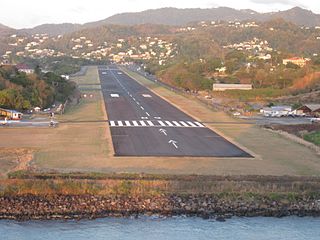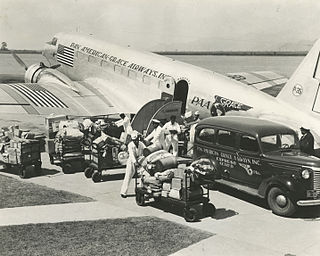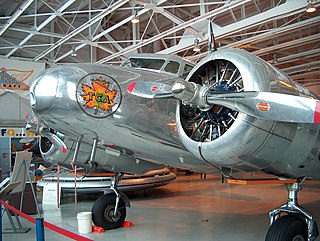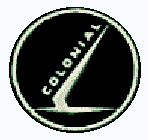
Luis Muñoz Marín International Airport is a joint civil-military international airport located in suburban Carolina, Puerto Rico, three miles (5 km) southeast of San Juan. It is named for Luis Muñoz Marín, Puerto Rico's first democratically elected governor, and was known as Isla Verde International Airport until it was renamed in February 1985. It is the busiest airport in the Caribbean region by passenger traffic. Over 4 million passengers board a plane at the airport per year according to the Federal Aviation Administration, making it the 48th busiest airport overseen by said federal agency.
Air Florida was an American low-cost carrier that operated under its own brand from 1972 to 1984. During the period from 1972 to 1978 Air Florida was an intrastate airline. Until a notorious 1982 aircraft crash in Washington DC, Air Florida was considered a high-profile early success of U.S. airline deregulation, having expanded rapidly from its original Florida network, including internationally to Europe and Latin America. After the crash, the airline struggled for over two and a half years before finally succumbing to bankruptcy in 1984.

Hewanorra International Airport, located near Vieux Fort Quarter, Saint Lucia, in the Caribbean, is the larger of Saint Lucia's two airports and is managed by the Saint Lucia Air and Seaports Authority (SLASPA). It is on the southern cape of the island, about 53.4 km (33.2 mi) from the capital city, Castries.
Air Jamaica was the national airline of Jamaica. It was owned and operated by Caribbean Airlines from May 2011 until the cessation of operations in 2015. Caribbean Airlines Limited, headquartered in Piarco, Trinidad and Tobago, had administrative offices for Air Jamaica located at Norman Manley International Airport in Kingston, Jamaica.
Arrow Air was a passenger and cargo airline based in Building 712 on the grounds of Miami International Airport (MIA) in Miami-Dade County, Florida. At different times over the years, it operated over 90 weekly scheduled cargo flights, had a strong charter business and at one point operated scheduled international and domestic passenger flights. Its main base was Miami International Airport. Arrow Air ceased operations on June 29, 2010, and filed for Chapter 11 bankruptcy protection on July 1, 2010. It was then liquidated.
Carnival Air Lines Incorporated was a charter and scheduled airline division of the Carnival Corporation & plc that started in 1988 after Carnival Cruise Lines purchased Pacific Interstate Airlines. It was headquartered in Dania Beach, Florida.
Capitol Air was a United States supplemental air carrier and, after 1978, a scheduled passenger air carrier based which was operational from 1946 to its bankruptcy filing on November 23, 1984. It was founded as Capitol Airways in 1946, and then renamed Capitol International Airways in 1967. In 1981, the airline changed its name to Capitol Air and was operating scheduled domestic and international passenger flights that year.

Las Américas International Airport is an international airport located in Punta Caucedo, near Santo Domingo and Boca Chica in the Dominican Republic. The airport is run by Aeropuertos Dominicanos Siglo XXI (AERODOM), a private corporation based in the Dominican Republic, under a 25-year concession to build, operate, and transfer (BOT) six of the country's airports. Las Américas usually receives a wide variety of long-, mid-, and short-haul aircraft. Santo Domingo's other airport, La Isabela, is much smaller and used by smaller aircraft only.

George F. L. Charles Airport is the smaller of the two airports in Saint Lucia, the other being Hewanorra International Airport. It is located 2 km (1.2 mi) north of Castries, the capital city. George F. L. Charles Airport is managed by the Saint Lucia Air and Seaports Authority (SLASPA). Its runway runs parallel to a pristine beach, Vigie Beach, which is a popular tourist attraction.

Pan American-Grace Airways, also known as Panagra, and dubbed "The World's Friendliest Airline" was an airline formed as a joint venture between Pan American World Airways and Grace Shipping Company. On September 13, 1928, a small single-engine Fairchild airliner flew from Lima, Peru, to Talara, Peru, which marked not only the beginning of Pan American Grace Airways but also the inauguration of scheduled air transportation along the West Coast of South America. From this short flight in 1928 to nonstop flights from New York to South America with Douglas DC-8 Intercontinental Jets in 1966, Panagra became the standard-bearer for transportation between the US Mainland East Coast and the West Coast of South America for 39 years. The "World's Friendliest Airline" merged with Braniff International Airways in 1967, and the combined carrier became the largest US airline serving South America.

Trans-Canada Air Lines was a Canadian airline that operated as the country's flag carrier, with corporate headquarters in Montreal, Quebec. Its first president was Gordon Roy McGregor. Founded in 1937, it was renamed Air Canada in 1965.
Marquette Airlines was a brief-lived trunk air carrier, a United States scheduled airline that operated between St. Louis to Detroit from 1938 to 1940 before merging into Transcontinental & Western Air (TWA).

Northeast Airlines was an American trunk carrier, a scheduled airline based in Boston, Massachusetts that chiefly operated in the northeastern United States, and later to Canada, Florida, the Bahamas, Los Angeles and other cities. It was acquired by and merged into Delta Air Lines in August 1972.

Bonanza Air Lines was a local service carrier as defined by the federal Civil Aeronautics Board) in the Western United States from 1945 until it merged with two other local service airlines to form Air West in 1968. Its headquarters was initially Las Vegas, Nevada, and moved to Phoenix, Arizona in 1966.

Caribair was a Puerto Rican airline based in San Juan, Puerto Rico, that served over a dozen destinations in the Caribbean as well as Miami. In 1970, the air carrier was serving 16 destinations on 14 Caribbean islands, plus Miami. The airline offered McDonnell Douglas DC-9-30 jet service via a number of intermediate stops including San Juan (SJU) for its direct flight services between Miami (MIA) and Port of Spain, Trinidad. Caribair was the first Puerto Rico-based airline to operate jet aircraft on scheduled passenger services. The air carrier was acquired by Eastern Air Lines in 1973.

Colonial Airlines was a United States trunk carrier, a scheduled airline that operated from 1928 to 1956 with bases at LaGuardia Airport (LGA) in New York City and at Montréal/St-Hubert Airport in Montreal, Canada, before merging into Eastern Air Lines.

California Central Airlines (CCA) was a post-war American scheduled price-focused intrastate airline based at Burbank, California, the most prominent airline associated with Charles C. Sherman. CCA slightly preceded, and during its existence was bigger than, its contemporary and competitor, Pacific Southwest Airlines (PSA). The core route of both airlines was from Los Angeles to the San Francisco Bay Area.
This is the history of United States commercial air transportation company American Airlines.
The history of non-scheduled airlines in the United States records the rise and fall of a uniquely unencumbered sector of the heavily regulated American airline industry from the end of World War II to the Airline Deregulation Act of 1978. Frequently operating in the shadow of colossal national airlines, which received federal subsidies and flew scheduled passenger service at costly rates, non-scheduled airlines were generally small companies which could be chartered to transport goods or passengers at an hourly or distance-based charge. Non-scheduled airlines were the first to introduce 'aircoach' fares for civilian air travel in the late 1940s, and brought about the low-rate service offered by almost all airlines operating today.

Canadian Colonial Airways, Limited ("Limited") was a Canadian airline founded in 1928 in Montreal, Quebec, as a 100%-owned subsidiary of Canadian Colonial Airways, Inc. ("Incorporated"), a United States airline, notwithstanding the name. The two airlines operated joint service between New York City and Montreal.














